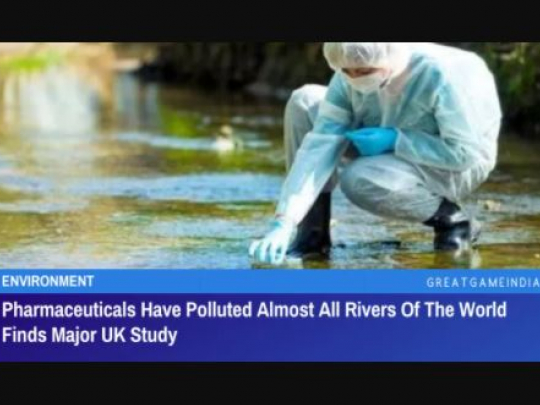Pharmaceuticals Have Polluted Almost All Rivers Of The World Finds Major UK Study

A major UK study finds that pharmaceutical manufacturing sites is the primary contributors of drug contamination and has polluted almost all the rivers of the world.
According to recent study, pharmaceutical contamination of the world’s rivers is significantly more widespread than previously assumed, and now constitutes a worldwide hazard to environmental and human health.
A group of experts from York University in the United Kingdom collected over 1,000 water samples from 258 rivers in 104 nations and discovered that many of them had levels of therapeutic medications that were dangerously high.
Only two rivers in Iceland and one near a community in Venezuela were fully untouched by pharmaceutical contamination because their residents do not utilise modern medication.
Lahore, Pakistan; La Paz, Bolivia; and Addis Ababa, Ethiopia had the largest concentrations. The Kai Tak River in Hong Kong Special Administrative Region (HKSAR) contained the most medications in a water sample, with 34 pharmaceuticals found.
Rivers in Belgium’s capital, Brussels, Luxembourg, and Dallas, Texas, were among the 20% of rivers with the greatest drug content. Four different medications were discovered in Antarctica.
The difficulties appear to be worse where wastewater treatment is least successful and in certain regions where pharmaceuticals are generated, according to the researchers, who collected samples from every continent.
They claim that the amount of drugs in rivers is a danger.
Drug-resistant killers
The finding of antibiotics in rivers is especially worrying, according to the study team, since it encourages bacteria to develop resistance to them.
A research published in the medical magazine The Lancet in January 2022 underlined the magnitude of the threat that antibiotic resistance poses. Antibiotic-resistant bacterial diseases killed about 5 million people in 2019, according to the report.
Antimicrobial resistance is one of the top ten worldwide public health challenges confronting humanity, according to the World Health Organization, with misuse and overuse being the major causes of medication resistance.
Antimicrobial resistance and Water: The Risks and Costs for Economies and Societies, a briefing paper published by the World Economic Forum, estimates that by 2050, antibiotic resistance would be responsible for up to 10 million fatalities per year.
The occurrence of drug-resistant bacteria is highest in Sub-Saharan Africa and South Asia, according to the study published in The Lancet, both of which were shown to have the highest levels of pharmaceutical pollution in the York University study.
According to the York study, the highest degree of antibiotic contamination was found in a river in Bangladesh, where metronidazole levels were 300 times higher than the permissible limit. The antibiotic ciprofloxacin was found in excess of permissible amounts in 64 rivers.
Health risks for rivers
Pharmaceuticals in our waterways endanger not just human health but also the environment. Other medications, such as contraceptives, can hinder fish from breeding and increase their susceptibility, resulting in less fish for humans to consume, according to the York study.
According to the report’s authors, the solution to the problem is to upgrade sewage systems and wastewater treatment. According to World Bank data, almost 80% of wastewater is dumped into the environment untreated.
The York team identified hospital waste, water-treatment facilities, septic tanks, and pharmaceutical manufacturing sites as the primary contributors of drug contamination in rivers, in addition to raw sewage discharge.
Dr. John Wilkinson, the study’s lead author, told The Guardian, “We know good sewage connectivity and wastewater treatment is the key to minimizing, though not necessarily eliminating, pharmaceutical concentrations.” “However, that is extremely expensive as there’s a lot of infrastructure involved.”
Analysts at the World Economic Forum agree. They anticipate that reaching global clean water standards will cost up to $47 billion per year. However, they claim that the advantages would include not just better health, but also more robust economies for some of the world ‘s poorest people.
- Source : GreatGameIndia


















